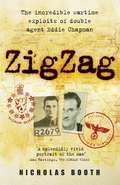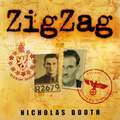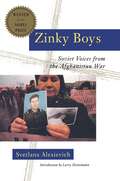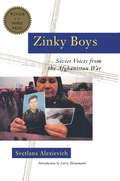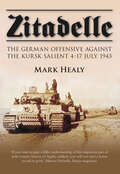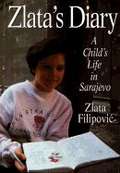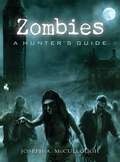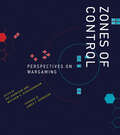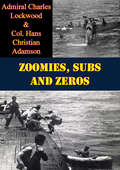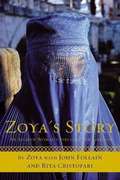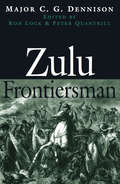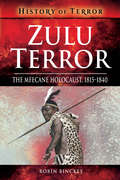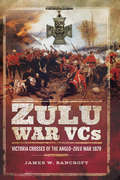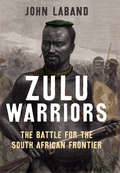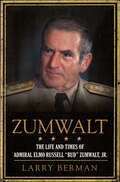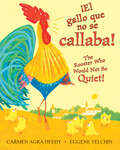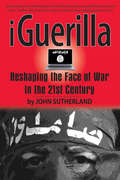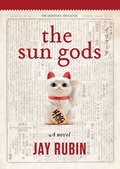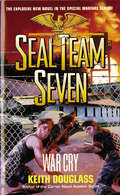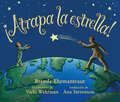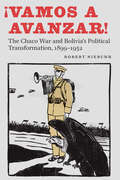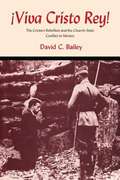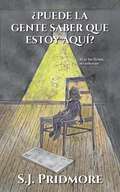- Table View
- List View
Zigzag: The incredible wartime exploits of double agent Eddie Chapman
by Nicholas BoothEddie Chapman was a womaniser, blackmailer and safecracker. He was also a great hero - the most remarkable double agent of the Second World War. Chapman became the only British national ever to be awarded an Iron Cross for his work for the Reich. He was also the only German spy ever to be parachuted into Britain twice. But it was all an illusion: Eddie fooled the Germans in the same way he conned his victims in civilian life. He was working for the British all along. Until now, the full story of Eddie Chapman's extraordinary exploits has never been told, thwarted by the Official Secrets Act. Now at last all the evidence has been released, including Eddie's M15 files, and a complete account of what he achieved is told in this enthralling book.
Zigzag: The incredible wartime exploits of double agent Eddie Chapman
by Nicholas BoothEddie Chapman was a womaniser, blackmailer and safecracker. He was also a great hero - the most remarkable double agent of the Second World War. Chapman became the only British national ever to be awarded an Iron Cross for his work for the Reich. He was also the only German spy ever to be parachuted into Britain twice. But it was all an illusion: Eddie fooled the Germans in the same way he conned his victims in civilian life. He was working for the British all along. Until now, the full story of Eddie Chapman's extraordinary exploits has never been told, thwarted by the Official Secrets Act. Now at last all the evidence has been released, including Eddie's M15 files, and a complete account of what he achieved is told in this enthralling book.
Zigzag: The incredible wartime exploits of double agent Eddie Chapman
by Nicholas BoothEddie Chapman was a womaniser, blackmailer and safecracker. He was also a great hero - the most remarkable double agent of the Second World War. Chapman became the only British national ever to be awarded an Iron Cross for his work for the Reich. He was also the only German spy ever to be parachuted into Britain twice. But it was all an illusion: Eddie fooled the Germans in the same way he conned his victims in civilian life. He was working for the British all along. Until now, the full story of Eddie Chapman's extraordinary exploits has never been told, thwarted by the Official Secrets Act. Now at last all the evidence has been released, including Eddie's M15 files, and a complete account of what he achieved is told in this enthralling book.
Zinky Boys: Soviet Voices From The Afghanistan War
by Svetlana AlexievichWinner of the Nobel Prize: “For her polyphonic writings, a monument to suffering and courage in our time.” ―Swedish Academy, Nobel Prize citation<P><P> From 1979 to 1989 a million Soviet troops engaged in a devastating war in Afghanistan that claimed 50,000 casualties―and the youth and humanity of many tens of thousands more. Creating controversy and outrage when it was first published in the USSR―it was called by reviewers there a “slanderous piece of fantasy” and part of a “hysterical chorus of malign attacks”―Zinky Boys presents the candid and affecting testimony of the officers and grunts, nurses and prostitutes, mothers, sons, and daughters who describe the war and its lasting effects. What emerges is a story that is shocking in its brutality and revelatory in its similarities to the American experience in Vietnam. The Soviet dead were shipped back in sealed zinc coffins (hence the term “Zinky Boys”), while the state denied the very existence of the conflict. Svetlana Alexievich brings us the truth of the Soviet-Afghan War: the beauty of the country and the savage Army bullying, the killing and the mutilation, the profusion of Western goods, the shame and shattered lives of returned veterans. Zinky Boys offers a unique, harrowing, and unforgettably powerful insight into the realities of war.<P><P> Translated by Larry Heinemann.
Zinky Boys: Soviet Voices From The Afghanistan War
by Svetlana AlexievichFrom the winner of the Nobel Prize for work that stands as "a monument to suffering and courage in our time" (Swedish Academy). Before the United States' invasion, a million Soviet troops fought a devastating war in Afghanistan that claimed 50,000 casualties—and the youth and humanity of many tens of thousands more. The Soviet Union talked about a "peacekeeping" mission, while the dead were shipped back in zinc-lined coffins. In this new translation, Zinky Boys weaves together the candid and affecting testimony of the officers and grunts, doctors and nurses, mothers, sons, and daughters who describe the war and its lasting effects. A "masterpiece of reportage" (Timothy Snyder, New York Review of Books) emerges of harrowing and unforgettable insight into war.
Zitadelle: The German Offensive Against the Kursk Salient 4-17 July 1943
by Mark HealyFew battles attract interest so much as the Battle of Kursk. Operation Zitadelle, the code name given by Hitler to the Wehrmacht's last offensive on the Eastern Front in July 1943, has acquired an almost mythic status as one of the greatest clashes of armour in the history of warfare. Long been depicted as the ‘the swan song of the German tank arm’ by virtue of the huge tank losses experienced by the Germans; the reality, in light of the emergence of new information proved it to be anything but, with historians previously accepting without question exaggerated Soviet accounts of the battle. For all the resources devoted to this operation by the Germans, Zitadelle was an abysmal failure; and whilst they were not outfought by the Red Army at Kursk, they were out-thought by commanders of outstanding quality. Zitadelle describes the German and Soviet tactics and explores the realities of the battles on sodden ground that culminated in the defeat of the panzers and the Soviet advance on the Reich.
Zlata's Diary: A Child's Life in Sarajevo
by Zlata Filipovic Christina Pribichevich-ZoricThis journal entry represents Zlata's insightful writing and the translators skill: "Thursday, October 14, 1993 Dear Mimmy, Those lunatics up in the hills must have read what I wrote about the shooting yesterday. They want to show me that they're still around. They went SHOOTING today. Shells fell around the market-place, and we don't know how Grandma and Grand-dad are. Poor things. These lunatics haven't just stolen from us our childhood, they've stolen from my grandparents and other old people a peaceful old age. They're not letting them live out the rest of their lives in peace. They had to ruin that too. I didn't have classes or music school today. They sent us home, so I'll spend the whole day at home reading, playing the piano, spending some time with Nejra and Haris. I was supposed to go to Mirna's today, but they spoiled that for me. I didn't tell you, Mimmy, that you're about to go out into the world. You're going to be published abroad. I allowed it, so you could tell the world what I wrote to you. I wrote to you about the war, about myself and Sarajevo in the war, and the world wants to know about it. I wrote what I felt, saw and heard, and now people outside of Sarajevo are going to know it. Have a good journey into the world. Your Zlata" A fine book for a book report. Teens sensitive to cruelty will want to share this diary with parents. This was a horrific piece of history.
Zombies
by Joseph McculloughThe dead have always stalked the dark corners of the earth. Since World War II, the number of zombie outbreaks has increased every year, while governments desperately try to cover up the facts. Zombies: A Hunter's Guide contains all of the information necessary to recognize and combat this growing threat. Beginning with an explanation of the historical origins of zombies, it follows their history straight through to the threat they pose to the world today. All varieties of zombie are catalogued and examined, giving their strengths and weakness, with a special emphasis on recognition and elimination. Finally, the book covers the tactics and equipment used in zombie fighting. Accompanied by numerous full-color reconstructions to help with identification, this book is a must for anyone on the frontlines of the Zombie Wars.From the Trade Paperback edition.
Zones of Control: Perspectives on Wargaming (Game Histories)
by Pat Harrigan Matthew G. KirschenbaumExaminations of wargaming for entertainment, education, and military planning, in terms of design, critical analysis, and historical contexts.Games with military themes date back to antiquity, and yet they are curiously neglected in much of the academic and trade literature on games and game history. This volume fills that gap, providing a diverse set of perspectives on wargaming's past, present, and future. In Zones of Control, contributors consider wargames played for entertainment, education, and military planning, in terms of design, critical analysis, and historical contexts. They consider both digital and especially tabletop games, most of which cover specific historical conflicts or are grounded in recognizable real-world geopolitics. Game designers and players will find the historical and critical contexts often missing from design and hobby literature; military analysts will find connections to game design and the humanities; and academics will find documentation and critique of a sophisticated body of cultural work in which the complexity of military conflict is represented in ludic systems and procedures.Each section begins with a long anchoring chapter by an established authority, which is followed by a variety of shorter pieces both analytic and anecdotal. Topics include the history of playing at war; operations research and systems design; wargaming and military history; wargaming's ethics and politics; gaming irregular and non-kinetic warfare; and wargames as artistic practice.ContributorsJeremy Antley, Richard Barbrook, Elizabeth M. Bartels, Ed Beach, Larry Bond, Larry Brom, Lee Brimmicombe-Wood, Rex Brynen, Matthew B. Caffrey, Jr., Luke Caldwell, Catherine Cavagnaro, Robert M. Citino, Laurent Closier, Stephen V. Cole, Brian Conley, Greg Costikyan, Patrick Crogan, John Curry, James F. Dunnigan, Robert J. Elder, Lisa Faden, Mary Flanagan, John A. Foley, Alexander R. Galloway, Sharon Ghamari-Tabrizi, Don R. Gilman, A. Scott Glancy, Troy Goodfellow, Jack Greene, Mark Herman, Kacper Kwiatkowski, Tim Lenoir, David Levinthal, Alexander H. Levis, Henry Lowood, Elizabeth Losh, Esther MacCallum-Stewart, Rob MacDougall, Mark Mahaffey, Bill McDonald, Brien J. Miller, Joseph Miranda, Soraya Murray, Tetsuya Nakamura, Michael Peck, Peter P. Perla, Jon Peterson, John Prados, Ted S. Raicer, Volko Ruhnke, Philip Sabin, Thomas C. Schelling, Marcus Schulzke, Miguel Sicart, Rachel Simmons, Ian Sturrock, Jenny Thompson, John Tiller, J. R. Tracy, Brian Train, Russell Vane, Charles Vasey, Andrew Wackerfuss, James Wallis, James Wallman, Yuna Huh Wong
Zoomies, Subs And Zeros
by Admiral Charles Lockwood Col. Hans Christian AdamsonThe exploits of the Submarine Rescue League, which had the job of picking up American flyers shot down while attacking objectives in the Pacific.'In writing this book, the authors had a triple purpose.First, to write the superbly human history of the Submarine Lifeguard League while those who participated in its creation and in its splendid work are still among us to tell that story. It is a chapter of Naval and Air Force operations in the Pacific that richly deserves preservation.Second, to convey to submariners whose vessels took part in the saving of the lives of hundreds of Air Force, Navy, and Marine Corps men an essential picture of the overall scope of their activities; as well as to give aviators whose lives were saved by submarines--and their families--a view of the far-flung operations established for snatching airmen from Japs as well as from death at sea.There remains one more reason for the writing of this book and, perhaps, it is, after all, the most important: namely, to impress upon those who have a voice in such matters at defense and Congressional levels that with new long-range planes and nuclear powered submarines, the lifesaving know-how acquired by submarine and air commanders through bitter and time-consuming experiences should be preserved for future generations of submariners and airmen.'-Author's Preface.
Zoya's Story: An Afghan Woman's Struggle for Freedom
by Zoya John Follain Rita CristofariZoya's Story is a young woman's searing account of her clandestine war of resistance against the Taliban and religious fanaticism at the risk of her own life. An epic tale of fear and suffering, courage and hope, Zoya's Story is a powerful testament to the ongoing battle to claim human rights for the women of Afghanistan. Though she is only twenty-three, Zoya has witnessed and endured more tragedy and terror than most people do in a lifetime. Zoya grew up during the wars that ravaged Afghanistan and was robbed of her mother and father when they were murdered by Muslim fundamentalists. Devastated by so much death and destruction, she fled Kabul with her grandmother and started a new life in exile in Pakistan. She joined the Revolutionary Association of the Women of Afghanistan, which challenged the crushing edicts of the Taliban government, and she made dangerous journeys back to her homeland to help the women oppressed by a system that forced them to wear the stifling burqa, condoned public stoning or whipping if they ventured out without a male chaperon, and forbade them from working. Zoya is our guide, our witness to the horrors perpetrated by the Taliban and the Mujahideen "holy warriors" who had defeated the Russian occupiers. She helped to secretly film a public cutting of hands in a Kabul stadium and to organize covert literacy classes, as schooling-branded a "gateway to Hell" -- was forbidden to girls. At an Afghan refugee camp she heard tales of heartrending suffering and worked to provide a future for families who had lost everything. The spotlight focused on Afghanistan after the New York and Washington terrorist attacks highlights the conditions of repression and fear in which Afghan women live and makes Zoya's Story utterly compelling. This is a memoir that speaks louder than the images of devastation and outrage; it is a moving message of optimism as Zoya struggles to bring the plight of Afghan women to the world's attention.
Zoya: An epic, unputdownable read from the worldwide bestseller
by Danielle SteelTHE WORLD'S FAVOURITE STORYTELLERNEARLY ONE BILLION COPIES SOLD One woman's odyssey through a century of turmoil . . . St Petersburg: one famous night of violence in the October Revolution ends the lavish life of the Romanov court forever - shattering the dreams of young Countess Zoya Ossupov.Paris: under the shadow of the Great War, émigrés struggle for survival as taxi drivers, seamstresses and ballet dancers. Zoya flees there in poverty - and leaves in glory.America: a glittering world of flappers, fast cars and furs in the Roaring Twenties; a world of comfort and café society that would come crashing down without warning. An epic and romantic tale from one of the best-loved writers of all time. Perfect for fans of Penny Vincenzi, Lucinda Riley and Maeve BinchyPRAISE FOR DANIELLE STEEL:'Emotional and gripping . . . I was left in no doubt as to the reasons behind Steel's multi-million sales around the world' DAILY MAIL'Danielle Steel is undeniably an expert' NEW YORK TIMES
Zulu Frontiersman
by Major C. G. DennisonIt was said of George Dennison that he had seen more active service in southern Africa than any other living man. An eminent soldier cast from a colonial mould of bitter experience, rather than of a formal military education, he was also a frontiersman equal in standing to any legendary figure of the American West. His military career saw him rise from an uncouth trooper with the Bloemfontein Rangers to, fifty years later, a distinguished officer whose advice was sought by the likes of Lord Kitchener, Sir Garnet Wolseley and other British military names of fame. During this time Dennison encountered many foes, some he would have known as neighbours, or men who had lately been his comrades-in-arms. He fought against Afrikaners, Dutchmen, Voortrekkers and the Boers. His black foes were also diverse; the stealthy Xhosa of the eastern Cape; the battle-axe wielding Basutos from their lofty kingdom in the clouds; the Transvaal baPedi, the masters of fortification, and most impressive of all, the amaZulu warriors of King Cetshwayo. In Zulu Frontiersman, Dennison recounts his remarkable exploits in rich and lively prose. Originally published in 1904 in abridged form (under the title A Fight to the Finish) his memoirs have now been expertly reworked by Ron Lock and Peter Quantrill in order to reinstate some of the fascinating details missing from the earlier published account, including for example Dennison's involvement in and dramatic escape from the battle of Hlobane.
Zulu Terror: The Mfecane Holocaust, 1815–1840 (History of Terror)
by Robin BinckesThe historian and author of The Great Trek recounts the devastating period of violence among indigenous peoples in early 19th century southern Africa. From 1815 to 1840, southeastern Africa experienced a devastating period of warfare between the Zulus, the Matabele, and other indigenous peoples. Though the causes of the unrest—which the Zulu called the Mfecane—are still debated by historians, we know that hundreds of thousands of lives lost. Some estimate the total number of deaths to be near two million. At the center of the turmoil was the Zulu Kingdom and its King Shaka, whose wars of expansion sparked mass migrations among smaller tribes. One of Shaka&’s lieutenants, Mzilikazi Khumalo, escaped execution and began a trail of destruction from Zululand north to the Highveld. Refugees from Mzilikazi&’s warpath then formed their own alliance—including with the Dutch-speaking Voortrekkers, arriving on their own &“Great Trek&” to escape British control. Finally defeated in 1836 by the Voortrekkers in a nine-day battle, Mzilikazi and his followers crossed the Limpopo River and founded the kingdom of the Matabele in what is now Zimbabwe.
Zulu War VCs: Victoria Crosses of the Anglo-Zulu War, 1879
by James W. BancroftThe Anglo-Zulu War lasted only six months in 1879, but in that relatively short time twenty-three men were awarded the Victoria Cross for gallantry under most trying and dangerous circumstances. Zulu warriors gave no mercy and expected none in return, yet half of the awards were given to men who went back into the midst of fierce fighting to rescue stranded comrades, well-aware that they risked suffering a particularly brutal death.Two men received posthumous awards for their efforts to save the Queens color of their regiment after the disastrous engagement against overwhelming numbers of warriors at Isandlwana, and perhaps the most famous of all awards of the Victoria Cross were the eleven gained for the immortal defence of Rorkes Drift, the battle brought back to the public consciousness by the motion picture _Zulu!_The conflict has never left the publics imagination, and continues to stir hot debate among military historians and enthusiasts.With information compiled over four decades by James W. Bancroft, a well-known and respected historian and author of several publications on the subject, this book brings together more information about the men than has ever before been collected together in one publication.
Zulu Warriors:The Battle for the South African Frontier
by John LabandToward the end of the nineteenth century, the British embarked on a concerted series of campaigns in South Africa. Within three years they waged five wars against African states with the intent of destroying their military might and political independence and unifying southern Africa under imperial control. This is the first work to tell the story of this cluster of conflicts as a single whole and to narrate the experiences of the militarily outmatched African societies.<P> Deftly fusing the widely differing European and African perspectives on events, John Laband details the fateful decisions of individual leaders and generals and explores why many Africans chose to join the British and colonial forces. The Xhosa, Zulu, and other African military cultures are brought to vivid life, showing how varying notions of warrior honor and manliness influenced the outcomes for African fighting men and their societies.
Zumwalt: The Life and Times of Admiral Elmo Russell "Bud" Zumwalt, Jr.
by Larry BermanAdmiral Elmo Russell Zumwalt, Jr., the charismatic chief of naval operations (CNO) and "the navy's most popular leader since WWII" (Time), was a man who embodied honor, courage, and commitment. In a career spanning forty years, he rose to the top echelon of the U.S. Navy as a commander of all navy forces in Vietnam and then as CNO from 1970 to 1974. His tenure came at a time of scandal and tumult, from the Soviets' challenge to the U.S. for naval supremacy and a duplicitous endgame in Vietnam to Watergate and an admirals' spy ring.Unlike many other senior naval officers, Zumwalt successfully enacted radical change, including the integration of the most racist branch of the military—an achievement that made him the target of bitter personal recriminations. His fight to modernize a technologically obsolete fleet pitted him against such formidable adversaries as Henry Kissinger and Hyman Rickover. Ultimately, Zumwalt created a more egalitarian navy as well as a smaller modernized fleet better prepared to cope with a changing world.But Zumwalt's professional success was marred by personal loss, including the unwitting role he played in his son's death from Agent Orange. Retiring from the service in 1974, Zumwalt spearheaded a citizen education and mobilization effort that helped thousands of Vietnam veterans secure reparations. That activism earned him the nation's highest civilian honor, the Presidential Medal of Freedom. Today Zumwalt's tombstone at the U.S. Naval Academy is inscribed with one word: "Reformer." Admiring yet evenhanded, Larry Berman's moving biography reminds us what leadership is and pays tribute to a man whose life reflected the best of America itself.
gallo que no se callaba!, ¡El / The Rooster Who Would Not Be Quiet!
by Carmen Agra DeedyPura Belpre Honoree Carmen Agra Deedy and Newbery Honor-book author/illustrator Eugene Yelchin have created a powerful tale that celebrates the spirit of freedom.La Paz es un pueblo alegre, pero ruidoso. Un poco de silencio no le vendría nada mal. Así que la gente del pueblo elige a don Pepe de alcalde para que resuelva el problema del ruido. Muy pronto, se prohíbe cantar en cualquier sitio. ¡Y hasta las teteras tienen miedo de pitar!Pero un gallito muy ruidoso, a quien le importa un pito las reglas del alcalde, sigue haciendo lo que los gallos hacen desde que nacen: ¡cantar!La Paz is a happy, but noisy village. A little peace and quiet would make it just right. So the villagers elect the bossy Don Pepe as their mayor. Before long, singing of any kind is outlawed. Even the teakettle is afraid to whistle!But there is one noisy rooster who doesn't give two mangos about this mayor's silly rules. Instead, he does what roosters were born to do.
iGuerilla: Reshaping the Face of War in the 21st Century
by John SutherlandiGuerilla: Reshaping the Face of War in the 21st Century, is a book in the tradition of Thomas Paine's Common Sense and Winston Churchill's The Gathering Storm. Like Paine, author John Sutherland alerts those in the large populace of the United States and Western Europe that an international war is underway. And like Churchill, he traces the trails of war to the present to bring an understanding of the changing nature of war and the psychology and goals of those who conduct it, and why they conduct it. The book is a projection of the future and delves into the manner in which the future will unveil. It is an illustration too, of how the war is being conducted, by those known as jihadists and the manner in which they use technology to return modern society to a dark age they call the Caliphate. The author describes in detail the weaknesses of those jihadists and how they can be defeated, and the manner that will quiet them for decades to come.
the sun gods
by Jay RubinArriving in Seattle on the eve of World War II, Japanese-born Mitsuko falls for Tom, a widowed pastor, and becomes surrogate mother to his fair-haired American toddler, Bill. But the bombing of Pearl Harbor strains the newly formed family as U. S. government mandates and Tom’s growing discomfort with all things Japanese force Mitsuko and young Bill to leave Seattle and Tom behind for the Minidoka Internment Camp, unsure if they will ever return. Two decades later, memories of Minidoka and long-lost Mitsuko haunt Bill, sparking an arduous journey that leads him from Seattle’s International District to newly reconstructed Japan to find his Japanese mother and learn the truth about their shared past. Jay Rubin is one of the foremost English-language translators of Japanese literature. He is best known for his numerous translations of works by Haruki Murakami, Japan’s leading contemporary novelist, and the study Haruki Murakami and the Music of Words. Most recently, he has translated the first two books of Murakami’s bestselling novel, 1Q84. In addition, Rubin’s Making Sense of Japanese remains one the widely used guides to Japanese language studies. Jay Rubin received his PhD in Japanese literature from the University of Chicago and taught at Harvard University and the University of Washington. He lives near Seattle with his wife.
war cry (Seal Team Seven #9)
by Keith DouglassSince 1953, the no-man's-land between North and South Korea has remained in a permanent stalemate...until now. As the vice president of the United States and several congressmen make an official inspection of the American border troops, the North Koreans launch a lightning-fast offensive with the goal of uniting Korea under their power. The officials are all captured, and held as prisoners of war. It's up to Lieutenant Blake Murdock and his SEALs to pull off a daring rescue behind enemy lines. But there is more bloody work to be done. In a day-to-day dance with death, the SEAL team proves again and again why they're the best. Then they get the orders they've been waiting for, orders that can stop the bloodshed: Hunt down the North Korean generals who instigated the war... and take them out!
¡Atrapa la estrella!
by Brenda Ehrmantraut—No será el mismo juego que solíamos hacer, sino algo muy especial cada atardecer. Cuando un soldado se tiene que ir al otro lado del mundo por su trabajo, él y su hijo juegan a tirar y atrapar la Estrella del Norte. ¡Atrapa la estrella! es una historia clásica que ayudará a las familias a sentirse cerca, aun cuando están lejos. La edición original en inglés, Night Catch, ha sido un título preferido desde el 2005. “... ¡Night Catch es lo mejor de lo mejor!” —Sally Ann Zoll, Directora General, United Through Reading “... un libro elemental en nuestro programa para padres ... ¡Lo recomendamos con entusiasmo!” —Military Child Education Coalition ~ “Not ball as usual in the park, but something special after dark.” When a soldier has to go to the other side of the world for his work, he and his son play a game with the North Star. ¡Atrapa la estrella! is a timeless story that helps families feel connected, even when they are separated. The English edition, Night Catch, has been a favorite since 2005! “... Night Catch is the best of the best! —Sally Ann Zoll, CEO, United Through Reading “... a staple in our Parent to Parent Program … We enthusiastically recommend it! —Military Child Education Coalition
¡Vamos a avanzar!: The Chaco War and Bolivia's Political Transformation, 1899–1952
by Robert NiebuhrIn ¡Vamos a avanzar! Robert Niebuhr argues that despite widespread corruption, a lack of skills, and failed policies, Bolivian leaders in the first half of the twentieth century created a modern state because of the profound role of warfare over the Chaco. When President Daniel Salamanca hastily thrust his isolated and poverty-stricken country into the devastation of the Chaco War against Paraguay in 1932, he unleashed a number of forces that had been brewing inside and outside of Bolivia, all of which combined to bring Bolivia a truly modern national identity and state-building program. This conflict was the defining moment whereby rhetoric and populism took on a broader meaning among the newly mobile populace, especially the Indigenous war veterans, as the Bolivians proclaimed, ¡Vamos a avanzar! (Let&’s move forward!). With the final revolution of 1952, politics in Bolivia became more modern than they had been in the period of the Chaco War or during the populist leanings of all post-1899 governments. Niebuhr offers a fresh contribution, showing the importance of the turbulent populist politics of the period after 1899 and the significance of the Chaco War as the most influential revolutionary event in modern Bolivian history.
¡Viva Cristo Rey! The Cristero Rebellion and the Church-State Conflict in Mexico
by David C. BaileyBetween 1926 and 1929, thousands of Mexicans fought and died in an attempt to overthrow the government of their country. They were the Cristeros, so called because of their battle cry, ¡Viva Cristo Rey!—Long Live Christ the King! The Cristero rebellion and the church-state conflict remain one of the most controversial subjects in Mexican history, and much of the writing on it is emotional polemic. David C. Bailey, basing his study on the most important published and unpublished sources available, strikes a balance between objective reporting and analysis. This book depicts a national calamity in which sincere people followed their convictions to often tragic ends.
¿Puede la gente saber que estoy aquí?
by S. J. PridmoreLa niña no entiende por qué le ha tocado vivir una vida tan cruel. Mientras, una joven madre se ve obligada a tomar una decisión imposible para salvar su vida y la de sus hijos. Ambas se encuentran solas en medio de un mundo hostil. Necesitan seguir libres si quieren sobrevivir. Porque jamás volverán si se las llevan, y es posible que el impetuoso espíritu que comparten no sea suficiente. Será necesaria la intervención de amables extraños y un golpe de suerte si han de tener alguna posibilidad de encontrar santuario. Sin embargo, son muchas las adversidades. Y no todos los extraños serán amables. Basado en una historia real.
